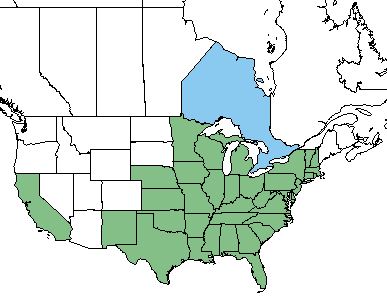Difference between revisions of "Tridens flavus"
| Line 46: | Line 46: | ||
<!--==Diseases and parasites==--> | <!--==Diseases and parasites==--> | ||
| − | ==Conservation and | + | ==Conservation, cultivation, and restoration== |
| − | == | + | ==Cultural use== |
==Photo Gallery== | ==Photo Gallery== | ||
<gallery widths=180px> | <gallery widths=180px> | ||
</gallery> | </gallery> | ||
==References and notes== | ==References and notes== | ||
Revision as of 13:05, 8 June 2021
Common name: redtop[1], tall redtop[1], purpletop tridens[1], greasy grass[1], Chapman's tridens[2]
| Tridens flavus | |
|---|---|

| |
| Photo by John Gwaltney hosted at Southeastern Flora.com | |
| Scientific classification | |
| Kingdom: | Plantae |
| Division: | Magnoliophyta - Flowering plants |
| Class: | Liliopsida - Moncots |
| Order: | Poales |
| Family: | Poaceae |
| Genus: | Tridens |
| Species: | T. flavus |
| Binomial name | |
| Tridens flavus (L.) Hitchc. | |

| |
| Natural range of Tridens flavus from USDA NRCS Plants Database. | |
Contents
Taxonomic Notes
Synonyms: Tridens chapmanii (Small) Chase.[3]
Description
T. flavus is a perennial graminoid of the Poaceae family native to North America and introduced to Canada.[2]
Distribution
T. flavus is found in the eastern half of the United States as well as California, and in the Ontario region of Canada. [2]
Ecology
Habitat
T. flavus proliferates in roadsides, disturbed areas, and glades.[1]
Specimens have been collected from drying loamy sands, burned pineland, bank of rivers, cypress swamp bank, open field, hammock, wooded floodplain, and pine-oak flatwood.[4]
Phenology
T. flavus has been observed to flower in October.[5]
Fire ecology
T. flavus is not fire resistant, but has high fire tolerance.[2]
Use by animals
T. flavus has high palatability for grazing and browsing animals.[2]
Conservation, cultivation, and restoration
Cultural use
Photo Gallery
References and notes
- ↑ 1.0 1.1 1.2 1.3 1.4 Weakley, A. S. (2015). Flora of the Southern and Mid-Atlantic States. Chapel Hill, NC, University of North Carolina Herbarium.
- ↑ 2.0 2.1 2.2 2.3 2.4 USDA Plant Database https://plants.usda.gov/core/profile?symbol=TRFL2
- ↑ Weakley, A.S. 2015. Flora of the southern and mid-atlantic states. Working Draf of 21 May 2015. University of North Carolina at Chapel Hill, Chapel Hill, North Carolina.
- ↑ URL: http://herbarium.bio.fsu.edu. Last accessed: June 2018. Collectors: Loran C. Anderson, R.K. Godfrey, Julia Neel, Roy Komarek, Robert Norris, A.F. Clewell, R. Kral, J. P. Gillespie, D.L. Martin, S. T. Cooper, R.D. Houk, Richard Mitchell, Cecil Slaughter, Marc Minno, Ann F. Johnson, Wilson Baker, Billie Bailey, Alan Franck, Peter Simones, M. Darst, A. Gholson, Kathleen Craddock Burks, Gary Knight. States and counties: Florida (Wakulla, Leon, Hamilton, Marion, Liberty, Jackson, Dixie, Okaloosa, Nassau, St. Johns, Volusia, Calhoun, Lafayette, Walton) Georgia (Grady, THomas)
- ↑ Nelson, G. PanFlora: Plant data for the eastern United States with emphasis on the Southeastern Coastal Plains, Florida, and the Florida Panhandle. www.gilnelson.com/PanFlora/ Accessed: 29 MAY 2018